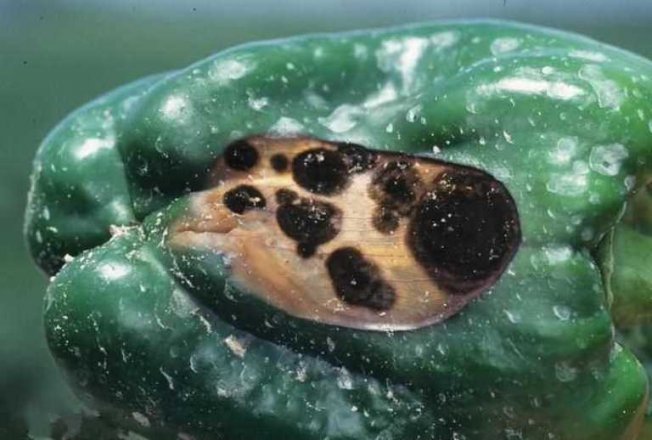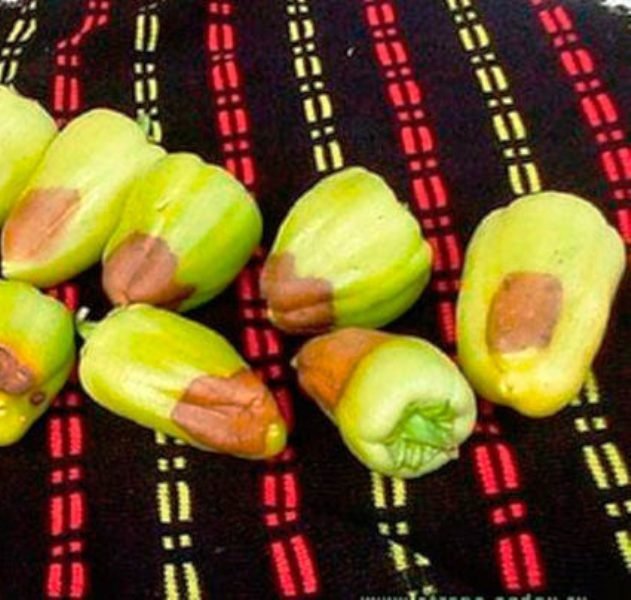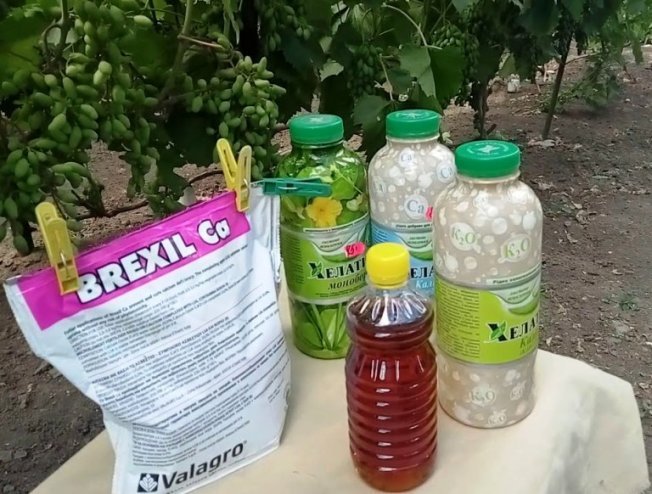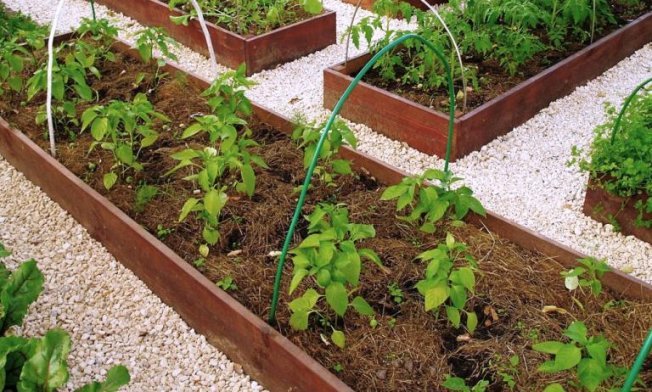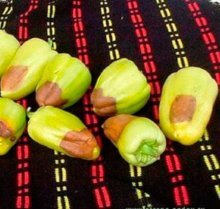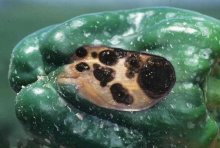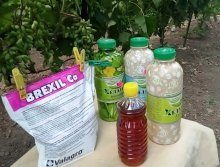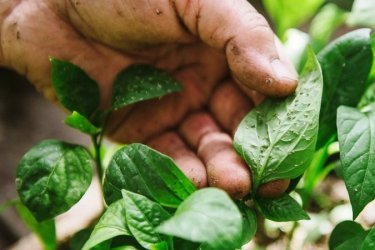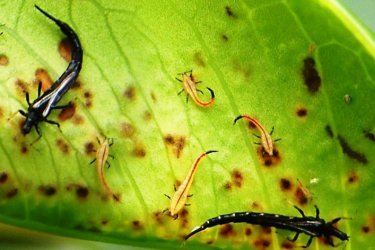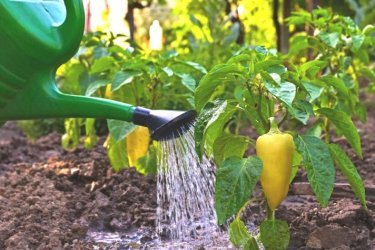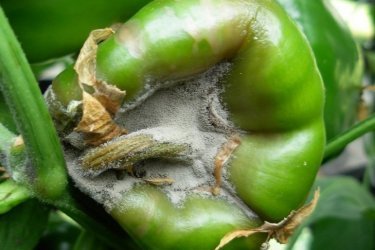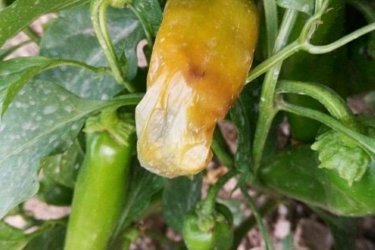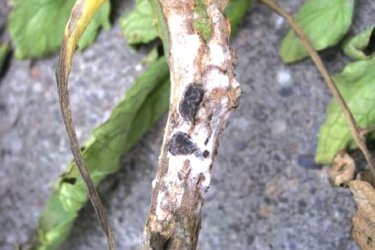Blossom rot on peppers, causes, methods of control

Blossom rot is a common disorder in nightshade crops: tomatoes suffer from it, and its symptoms often appear on peppers. Fortunately, the disease is not infectious; it can develop on crops grown in open ground and greenhouses.
Content:
- What does it look like in the photo, what symptoms does it manifest?
- For what reasons does pathology occur?
- Bacterial form of the disease
- Blossom rot on peppers in greenhouses and open ground
- Drugs to combat the disease
- Traditional methods of treatment
- Preventive measures
What does it look like in the photo, what symptoms does it manifest?
Vershinnaya rot on peppers most often affects unripe fruits. Its initial stage consists of small dark spots on the upper part of the fruit. They may have a gray or brown tint; the watery formations quickly increase in size and become hard to the touch.
In some cases, external manifestations are barely noticeable, but when cutting the fruit, browned or blackened tissue is observed.
For what reasons does pathology occur?
Reasons that provoke the development of blossom end rot on peppers:
- air temperature above + 25 - + 30 C;
- lack of moisture, or sudden changes in humidity;
- insufficient lighting;
- unbalanced feeding;
- heavy soil that prevents normal breathing of roots;
- damage to roots during weeding.
As the air temperature rises, the leaves quickly evaporate moisture; if there is not enough moisture in the soil, or the roots do not cope well with their tasks, then the process of moisture outflow from the fruits into the leaves begins. This process causes partial death of cells at the tops of the pods.
Bushes planted on saline or acidified soils suffer more from this phenomenon.
The manifestation of identical symptoms is caused by a lack of phosphorus, manganese, calcium in the soil, or an excess of nitrogen, magnesium, and potassium.
Note that with a lack of calcium, external signs of the disease may not appear, but cutting into the fruit you can see the affected brown spots.
Bacterial form of blossom end rot
In addition to physiological pathology, the appearance of blossom-end rot can be caused by pathogenic bacteria found in the soil, the remains of dead plants, and they can also be spread by insects.
Among the dangerous provoking factors, we also note air temperatures above + 28 +30 C with humidity above 70%. Such conditions often occur in greenhouses.
The bacterial form of the disease affects fruits lying on or touching the ground. This happens if the bushes are not tied up, especially if the first clusters of fruit are located very low.
Blossom rot on peppers in greenhouses and in open ground
The disease appears during the period when the crop ripens. At the initial stage, watery areas appear; after increasing in size, they acquire a dark gray or brown color. The cause of dark spots is actively reproducing saprophytic fungi.
The skin on damaged surfaces becomes rough and seems to be pulled inward. Necrotic changes occur in the thickness of the walls of the fruit, this is clearly visible when cut
Blossom rot is a non-infectious disease, however, fruits damaged by it often suffer from fungal or viral damage.
If, due to weather conditions, the situation with blossom end rot repeats from year to year, then planting pepper varieties resistant to it would be a good option.
We indicate them in Table 1.
| Pepper variety | Brief characteristics |
| Eroshka | High-yielding, can be grown in open ground and greenhouses. Relatively resistant to viral diseases and blossom end rot |
| Miracle tree f1 | Hybrid designed for closed ground. Tolerates poor lighting and is resistant to blossom end rot. |
| Agapovsky | Gives excellent yields when grown in open ground and greenhouses. Rarely gets sick. Resistant to sudden temperature changes |
| Latino f1 | An early-ripening, high-yielding hybrid that is resistant to stress and weather changes |
Let's watch a useful video about blossom end rot on peppers and the reasons for its occurrence:
Biological and chemical means of combating the disease
You can fight blossom end rot on peppers in greenhouses and open ground using fairly effective drugs that are widely available in gardening stores.
To make it more convenient to study, let’s compile Table 2.
| Drug name | How to prepare the composition | Expected results |
| Potassium humate, or Gumifield | 5g per 50 liters of water | Increasing resistance to droughts and diseases. Stimulation of growth |
| Megafol | 20 ml per 10 liters of water | Protection against stress, stimulation of plant growth.Providing the mineral elements necessary for growth. |
| Brexil calcium | 1.5 - 2 g per 1 liter of water | Eliminates boron and calcium deficiency, prevents the development of pathologies |
| Fitosporin | 3 teaspoons per 10 liters of water | Biofungicide that inhibits the development of blossom end rot |
Folk remedies for treatment
To combat pepper disease, use:
- When the first signs appear, use an infusion of 50 g of bone meal in 1 liter of boiling water, leave the solution for a week, filter, dilute with 20 liters of water. Used to process leaves.
- calcium acetate solution. It is prepared by mixing 1 liter of 9% vinegar and one glass of chalk; upon completion of the chemical reaction, the product is diluted in 30 liters of water;
Wood ash is an equally effective remedy. Its infusion is added to water for watering bushes, and plants are dusted with it.
Preventive measures
There are many remedies for treating tip rot on peppers in greenhouses and open ground. But as the optimal option, we will still name the competent use of preventive measures.
Watering should be planned taking into account weather conditions; in hot weather you will need to add more water. During this period, it is rational to use drip irrigation, which ensures uniform soil moisture and does not provoke an increase in air humidity.
Mulching beds is beneficial; dried grass, rotted sawdust, straw, and compost can be used as mulch.
Excess leaves from the bushes should be removed; this procedure will reduce the evaporation of moisture, and accordingly, its outflow will be less.
Acidic soils should be limed and dolomite flour and ash added.
Before sowing, it is important to treat the seeds with a solution of potassium permanganate, zinc sulfate, copper sulfate, and growth stimulants.
Greenhouses should be well ventilated, soil temperature and humidity should be controlled.
Disease-affected fruits should be removed from the bushes. Plants, if necessary, are fixed on supports. Stepchildren should be removed carefully, causing minimal trauma to the plants.
Let's watch another video with useful tips from an experienced agronomist:
Knowing the nature of blossom end rot and the reasons why it affects peppers, experienced vegetable growers deal with the problem fairly quickly. In this case, the application of complete fertilizing, treatment of plants and timely watering are effective.
Pests

